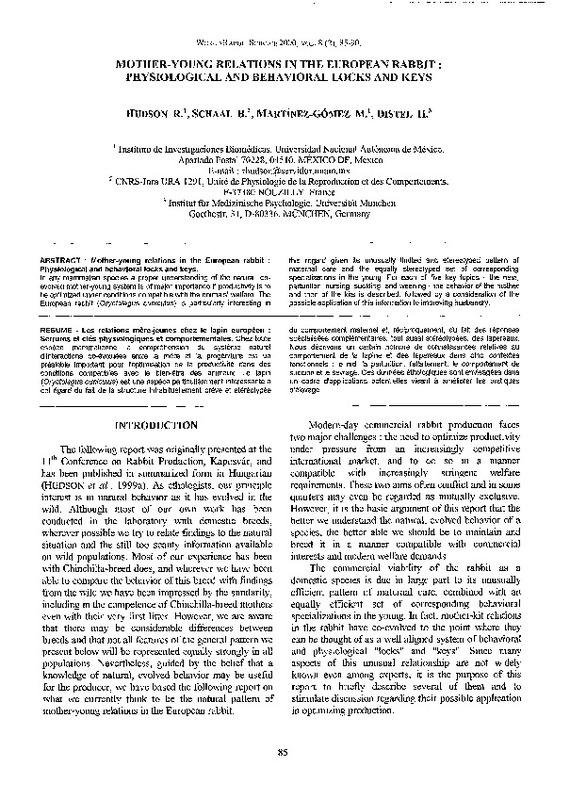JavaScript is disabled for your browser. Some features of this site may not work without it.
Buscar en RiuNet
Listar
Mi cuenta
Estadísticas
Ayuda RiuNet
Admin. UPV
MOTHER-YOUNG RELATIONS IN THE EUROPEAN RABBIT : PHYSIOLOGICAL AND BEHAVIORAL LOCKS AND KEYS
Mostrar el registro sencillo del ítem
Ficheros en el ítem
| dc.contributor.author | Hudson, R.
|
|
| dc.contributor.author | Schaal, B.
|
|
| dc.contributor.author | Martínez-Gómez, M.
|
|
| dc.contributor.author | Distel, H.
|
|
| dc.date.accessioned | 2011-03-09T08:36:19Z | |
| dc.date.available | 2011-03-09T08:36:19Z | |
| dc.date.issued | 2000 | |
| dc.identifier.issn | 1257-5011 | |
| dc.identifier.uri | http://hdl.handle.net/10251/10235 | |
| dc.description.abstract | [EN] In any mammalian species a proper understanding of the natural, coevolved mother-young system is of major importance if productivity is to be optimized under conditions compatible with !he animals' welfare. The European rabbit (Oryctolagus cunicu/us) is particularly interesting in this regard given its unusually limited and stereotyped pattern of maternal care and the equally stereotyped set of corresponding specializations in !he young. For each of five key topics - the nest, parturition, nursing, suckling, and weaning - the behavior of the mother and then of the kits is described, followed by a consideration of !he possible application of this information to improving husbandry. | es_ES |
| dc.description.abstract | [FR] Chez toute espéce mammalienne la compréhension du systeme naturel d'interactions co-évoluées entre la mere et la progéniture est un préalable importan! pour l'optimisation de la productivité dans des conditions compatibles avec le bien-etre des animaux. Le lapin (Orycto/agus cuniculus) est une espece particulierement intéressante a cet égard du fait de la structure inhabituellement breve et stéréotypée du comportement maternel et, réciproquement, du fait des réponses spécialisées complémentaires, tout aussi stéréotypées, des lapereaux. Nous décrivons un certain nombre de connaissances relatives au comportement de la lapine et des lapereaux dans cinq contextes fonctionnels : le nid, la parturition, l'allaitement, le comportement de succion et le sevrage. Ces données éthologiques sont envisagées dans un cadre d'applications potentielles visant a améliorer les pratiques d'élevage. | |
| dc.language | Inglés | es_ES |
| dc.publisher | World Rabbit Science. ICTA. UPV | es_ES |
| dc.relation.ispartof | World Rabbit Science | |
| dc.rights | Reserva de todos los derechos | es_ES |
| dc.title | MOTHER-YOUNG RELATIONS IN THE EUROPEAN RABBIT : PHYSIOLOGICAL AND BEHAVIORAL LOCKS AND KEYS | es_ES |
| dc.type | Artículo | es_ES |
| dc.date.updated | 2011-03-08T12:56:33Z | |
| dc.identifier.doi | 10.4995/wrs.2000.424 | |
| dc.rights.accessRights | Abierto | es_ES |
| dc.description.bibliographicCitation | Hudson, R.; Schaal, B.; Martínez-Gómez, M.; Distel, H. (2000). MOTHER-YOUNG RELATIONS IN THE EUROPEAN RABBIT : PHYSIOLOGICAL AND BEHAVIORAL LOCKS AND KEYS. World Rabbit Science. 08(2). https://doi.org/10.4995/wrs.2000.424 | es_ES |
| dc.description.accrualMethod | SWORD | es_ES |
| dc.relation.publisherversion | https://doi.org/10.4995/wrs.2000.424 | |
| dc.description.volume | 08 | |
| dc.description.issue | 2 | |
| dc.identifier.eissn | 1989-8886 | es_ES |








